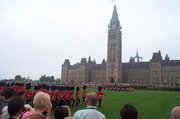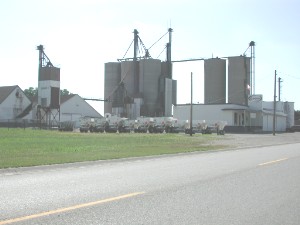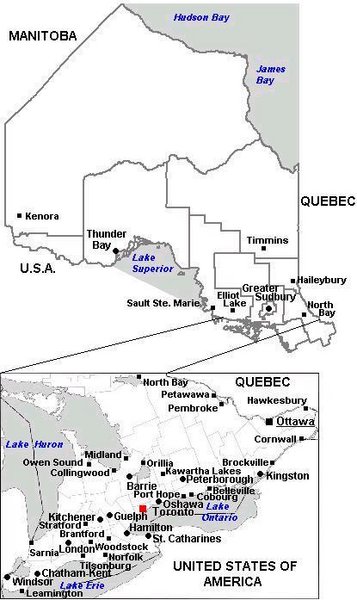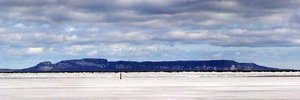Ontario
|
|
Template:Canadian province or territory
- This article describes the Canadian province. For other usages, see Ontario (disambiguation).
Ontario is the most populous of Canada's ten provinces. It is found in east-central Canada. Its capital is Toronto. Ottawa, the capital of Canada, is also located in Ontario. Ontario has a population (January 1, 2005) of 12,449,502, representing about 39% of the total Canadian population (Ontarians) and an area of 1,076,395km² (415,000 mi²) .
| Contents |
Geography
20588549.jpg
Ontario is bounded on the north by Hudson Bay and James Bay, on the east by Quebec, on the west by Manitoba, and on the south by the American states of Minnesota, Wisconsin, Michigan, Ohio, Pennsylvania and New York. Ontario's long American border is formed almost entirely by lakes and rivers, starting in Lake of the Woods and continuing to the Saint Lawrence River near Cornwall; it passes through the four Great Lakes on which Ontario has coastline, namely Lakes Superior, Huron (which includes Georgian Bay), Erie, and Ontario (for which the province is named; Ontario itself is an Iroquois word meaning "beautiful lake" or "beautiful water"). There are approximately 250,000 lakes and over 100,000 kilometres of rivers in the province.
The largest city and capital of the province is Toronto, the main component of the Golden Horseshoe conurbation surrounding the western portion of Lake Ontario. The capital of Canada, Ottawa, is in the far east of the province, on the Ottawa River which forms most of the border with Quebec.

The province consists of three main geographical regions: the Canadian Shield in the northwestern and central portions, a mainly infertile area rich in minerals and studded with lakes and rivers; the Hudson Bay Lowlands in the northeast, mainly swampy and forested; and the temperate, and therefore most populous region, the fertile Great Lakes-Saint Lawrence Valley in the south where agriculture and industry are concentrated. The northern extent of the Carolinian forest zone is found in the southwestern section. The Saint Lawrence Seaway allows navigation to and from the Atlantic Ocean as far as Thunder Bay in Northern Ontario which occupies 90 per cent of the surface area of the province. Southern Ontario contains 90 per cent of the population (see article Geography of Canada).
Point Pelee National Park is a peninsula in southeastern Ontario (near Windsor, Ontario and Detroit, Michigan) that extends into Lake Erie and is the part of Canada's mainland furthest south. Pelee Island in Lake Erie is even further south. Both are south of 42°N and further south than the northern border of California.
Increasing immigration from all parts of the world, especially to Toronto and its environs, is rapidly diversifying the province's ethnic makeup. About five per cent of the population of Ontario is Franco-Ontarian.
10 Largest Municipalities by population
| Municipality | 2001 | 1996 |
|---|---|---|
| Toronto | 2,481,494 | 2,385,421 |
| Ottawa | 774,072 | 721,136 |
| Mississauga | 612,925 | 544,382 |
| Hamilton | 490,268 | 467,799 |
| London | 336,539 | 325,669 |
| Brampton | 325,428 | 268,251 |
| Markham | 208,615 | 173,383 |
| Windsor | 208,402 | 197,694 |
| Kitchener | 190,399 | 178,420 |
| Vaughan | 182,022 | 132,549 |
Economy
5358594.jpg
Ontario's rivers, particularly its share of the Niagara River, make it rich in hydroelectric energy. This competitive advantage, as well as excellent transportation links to the American heartland, has contributed to making manufacturing the principal industry, found mainly in the Golden Horseshoe region, the most industrialized area in Canada. Important products include motor vehicles, iron, steel, food, electrical appliances, machinery, chemicals, and paper. Ontario rivals the American state of Michigan in car production, assembling 2.696 million vehicles in 2004 (see Auto Pact). Some economists believe that the North American Free Trade Agreement has led to a decline in manufacturing, and that there is evidence that Ontario is part of North America's manufacturing "Rust Belt".
Toronto is the centre of Canada's financial services and banking industry. The technology sector is also important, especially around Markham, Waterloo and Ottawa. Mining and the forest products industry, notably pulp and paper, are important to the economy of the Canadian Shield of Northern Ontario.
Nominal Gross Domestic Product in 2003 was an estimated C$494,229,000,000 (40.6% of the Canadian total), larger than the GDP of Austria, Belgium or Sweden. Broken down by sector, the Primary Sector is 1.8% of total GDP, Secondary Sector 28.5%, and Service Sector 69.7%.
Further economic information on provincial GDP etc. at Ontario Facts (http://www.2ontario.com/welcome/oo_000.asp)
Agriculture
London, Ontario
Once the dominant industry, agriculture occupies a small percentage of the population. The number of farms has decreased from 68,633 in 1991 to 59,728 in 2001, but farms have increased in average size. Cattle, small grains and dairy were the common types of farms in the 2001 census. The fruit, grape and vegetable growing industry is located primarily on the Niagara Peninsula and along Lake Erie. The Ontario origins of Massey-Ferguson Ltd., once one of the largest farm implement manufacturers in the world, indicate the importance agriculture once had to the Ontario economy (see Geography of Canada for more detail).
History
To 1867
Before the arrival of the Europeans, the region was inhabited both by Algonquian (Ojibwa, Cree and Algonquin) and Iroquoian (Iroquois and Huron) tribes. The French explorer Étienne Brûlé explored part of the area in 1610-12. The English explorer Henry Hudson sailed into Hudson Bay in 1611 and claimed the area for England, but Samuel de Champlain reached Lake Huron in 1615 and French missionaries began to establish posts along the Great Lakes. French settlement was hampered by their hostilities with the Iroquois, who would ally themselves with the British.
The British established trading posts on Hudson Bay in the late 17th century and began a struggle for domination of Ontario. The 1763 Treaty of Paris ended the Seven Years War by awarding nearly all of France's North American possessions (New France) to Britain. The region was annexed to Quebec in 1774. From 1783 to 1796, the United Kingdom granted United Empire Loyalists leaving the United States following the American Revolution 200 acres (0.8 km²) of land and other items with which to rebuild their lives. This measure substantially increased the population of Canada west of the Ottawa River during this period, a fact recognized by the Constitutional Act of 1791, which split Quebec into The Canadas: Upper Canada west of the Ottawa River, and Lower Canada east of it. John Graves Simcoe was appointed Upper Canada's first Governor-General in 1793.
American troops in the War of 1812 invaded Upper Canada across the Niagara River and the Detroit River but were successfully pushed back by British and Native American forces. The Americans gained control of Lake Erie and Lake Ontario, however, and during the Battle of York occupied the Town of York (later named Toronto) in 1813. Not able to hold the town, the departing soldiers burned it to the ground.
After the War of 1812, many settlers from the British Isles immigrated to Upper Canada, and began to chafe against the aristocratic Family Compact that governed the region, much as the Château Clique ruled Lower Canada. Accordingly, rebellion in favour of responsible government rose in both regions; Louis-Joseph Papineau led the Patriotes Rebellion in Lower Canada, and William Lyon Mackenzie led the Upper Canada Rebellion. For more on the rebellions of 1837, see History of Canada.
Although both rebellions were crushed, the British government sent Lord Durham to investigate the causes of the unrest. He recommended that self-government be granted and that Lower and Upper Canada be re-joined in an attempt to assimilate the Québécois. Accordingly, the two colonies were merged into the Province of Canada by the Act of Union (1840), with Ontario becoming known as Canada West. Parliamentary self-government was granted in 1848. By about 1850, the English-speaking population of Canada West surpassed the French-speaking population of Canada East.
A political stalemate between the French- and English-speaking legislators, as well as fear of aggression from the United States during the American Civil War, led the political elite to hold a series of conferences in the 1860s to effect a broader federal union of all British North American colonies. The British North America Act took effect on July 1, 1867, establishing the Dominion of Canada, initially with four provinces: Nova Scotia, New Brunswick, Quebec and Ontario. The Province of Canada was divided at this point into Ontario and Quebec so that each linguistic group would have its own province. Both Quebec and Ontario were required by section 93 of the BNA Act to safeguard existing educational rights and privileges of the Protestant and Catholic minorities. Neither province had a constitutional requirement to protect its French- or English-speaking minority. Toronto was formally established as Ontario's provincial capital at this time.
From 1867 to 1896
Once constituted as a province, Ontario proceeded to assert its economic and legislative power. In 1872 the lawyer Oliver Mowat became premier, and would remain as premier until 1896. He fought for provincial rights, weakening the power of the federal government in provincial matters, usually through well-argued appeals to the Judicial Committee of the Privy Council. His battles with the federal government greatly decentralized Canada, giving the provinces far more power than John A. Macdonald had intended. He consolidated and expanded Ontario's educational and provincial institutions, created districts in Northern Ontario, and fought tenaciously to ensure that those parts of Northwestern Ontario not historically part of Upper Canada (the vast areas north and west of the Lake Superior-Hudson Bay watershed, known as the District of Keewatin) would become part of Ontario, a victory embodied in the Canada (Ontario Boundary) Act, 1889. He also presided over the emergence of the province into the economic powerhouse of Canada. Mowat was the creator of what is often called Empire Ontario.
Beginning with Sir John A. Macdonald's the National Policy (1879) and the construction of the Canadian Pacific Railway (1875-1885) through Northern Ontario and the Prairies to British Columbia, Ontario manufacturing and industry flourished.
From 1896 to the present
Mineral exploitation began in the late 19th century, leading to the rise of important mining centres like Sudbury, Cobalt and Timmins. The province harnessed its water power to generate hydro-electric power, and created the state-controlled Hydro-Electric Power Commission of Ontario, later Ontario Hydro. The availability of cheap electric power further facilitated the development of industry. In 1904 the Canadian automobile industry was launched in what is now Windsor, Ontario with the establishment of the Ford Motor Company of Canada. General Motors of Canada Ltd. was formed in 1918. The motor vehicle industry would become the major industrial component of the Ontario economy.
In July 1912 the Conservative government of Sir James P. Whitney issued Regulation 17 which severely limited the availability of French-language schooling to the province's French-speaking minority. French-Canadians reacted with outrage, journalist Henri Bourassa denouncing the "Prussians of Ontario". It was eventually repealed in 1927.
Influenced by events in the United States, the government of Sir William Hearst introduced prohibition of alcoholic drinks in 1916 with the passing of the Ontario Temperance Act. Prohibition came to an end in 1927 with the establishment of the Liquor Control Board of Ontario by the government of George Howard Ferguson. The sale of liquor and beer is still tightly-controlled by the state to ensure that the maximum revenues go to the provincial treasury.
The post-World War II period was one of exceptional prosperity and growth. Ontario, and the Greater Toronto Area in particular, have been the recipients of most immigration to Canada. Changes in federal immigration law have led to a massive influx of non-Europeans since the 1980s. From a largely ethnically British province, Ontario has now become very culturally diverse.
The nationalist movement in Quebec, particularly after the election of the Parti Québécois in 1976, contributed to driving many businesses out of the province to Ontario, and Toronto surpassed Montreal as the largest city and economic centre of Canada.
Government
The British North America Act 1867 section 69 stipulated "There shall be a Legislature for Ontario consisting of the Lieutenant Governor and of One House, styled the Legislative Assembly of Ontario". The assembly has 103 seats representing ridings elected in a first-past-the-post system across the province. The legislative buildings at Queen's Park in Toronto are the seat of government. Following the Westminster system, the leader of the party currently holding the most seats in the assembly is known as the "Premier and President of the Council" (Executive Council Act R.S.O. 1990). The Premier chooses the cabinet or Executive Council whose members are deemed "ministers of the Crown". Although the Legislative Assembly Act (R.S.O. 1990) refers to members of the assembly, the legislators are now called MPPs (Members of the Provincial Parliament) in English and députés de l'Assemblée législative in French, but they have also been called MLAs (Members of the Legislative Assembly), and both are acceptable. The title of Prime Minister of Ontario, while permissible in English and correct in French (le Premier ministre), is generally avoided in favor of "Premier" to avoid confusion with the Prime Minister of Canada.
Politics
Main article: Politics of Ontario
Territorial evolution 1788-1899
Land was not legally subdivided into administrative units until a treaty had been concluded with the native peoples ceding the land (see Royal Proclamation of 1763). In 1788, while part of the Province of Quebec (1763-1791), southern Ontario was divided into four districts: Hesse, Lunenburg, Mecklenburg, and Nassau.
In 1792 the four districts were renamed: Hesse became the Western District, Lunenburg became the Eastern District, Mecklenburg became the Midland District, and Nassau became the Home District. Counties were created within the districts.
By 1798 there were eight districts: Eastern, Home, Johnstown, London, Midland, Newcastle, Niagara and Western.
By 1826 there were eleven districts: Bathurst, Eastern, Gore, Home, Johnstown, London, Midland, Newcastle, Niagara, Ottawa, and Western.
By 1838 there were twenty districts: Bathurst, Brock, Colbourne, Dalhousie, Eastern, Gore, Home, Huron, Johnstown, London, Midland, Newcastle, Niagara, Ottawa, Prince Edward, Simcoe, Talbot, Victoria, Wellington and Western.
In 1849 the districts of southern Ontario were abolished by the Province of Canada and county governments took over certain municipal responsibilities. The Province of Canada also began creating districts in sparsely populated Northern Ontario with the establishment of Algoma District and Nipissing District in 1858.
The northern and western boundaries of Ontario were in dispute after Confederation. Ontario's right to Northwestern Ontario was determined by the Judicial Committee of the Privy Council in 1884 and confirmed by the Canada (Ontario Boundary) Act, 1889 of the Parliament of the United Kingdom. By 1899 there were seven northern districts: Algoma, Manitoulin, Muskoka, Nipissing, Parry Sound, Rainy River, and Thunder Bay. Four more northern districts were created between 1907 and 1912: Cochrane, Kenora, Sudbury and Temiskaming.
- Early Districts and Counties 1788-1899 (http://www.archives.gov.on.ca/english/exhibits/maps/districts.htm)
See also
- Canada
- Franco-Ontarian
- Legislative Assembly of Ontario
- List of Ontario-related topics
- List of cities in Canada
- List of Ontario premiers
- List of Lieutenant Governors of Ontario
- List of communities in Ontario
- List of Ontario counties
- List of Canadian provincial and territorial symbols
- List of Ontario Universities
- List of Ontario Colleges of Applied Arts and Technology
- Northern Ontario
- Northwestern Ontario
- Ontario Court of Appeal
- Coat of Arms of Ontario
- Order of Ontario
- Timeline of Ontario history
External link
- Government of Ontario (http://www.gov.on.ca/)
- Map (http://atlas.gc.ca/rasterimages/english/maps/reference/provincesterritories/ont_new.pdf)
- Ontario Ghost Towns and Abandoned Places (http://www.ontarioghosttowns.com/)
| Provinces and territories of Canada | 
| ||||||||||||||||||||||||||||
| |||||||||||||||||||||||||||||
| Census Divisions of Ontario | 
| ||
|---|---|---|---|
| Counties of Ontario: Bruce | Dufferin | Elgin | Essex | Frontenac | Grey | Haliburton | Hastings | Huron | Lambton | Lanark | Leeds and Grenville | Lennox and Addington | Middlesex | Northumberland | Perth | Peterborough | Prescott and Russell | Renfrew | Simcoe | Stormont, Dundas and Glengarry | Wellington | |||
| Regional Municipalities of Ontario: Durham | Halton | Muskoka | Niagara | Oxford | Peel | Waterloo | York | |||
| Single Tier Municipalities of Ontario: Brant | Brantford | Chatham-Kent | Greater Sudbury | Haldimand | Hamilton | Kawartha Lakes | Norfolk | Ottawa | Prince Edward | Toronto | |||
| Separated municipalities - Historic counties of Ontario | |||
| Districts of Ontario: Algoma | Cochrane | Kenora | Manitoulin | Nipissing | Parry Sound | Rainy River | Sudbury | Thunder Bay | Timiskaming | |||
ang:Ontario da:Ontario de:Ontario et:Ontario provints es:Ontario eo:Ontario fr:Ontario io:Ontario iu:ᐋᓐᑎᐅᕆᔪ it:Ontario he:אונטריו ka:ონტარიო (პროვინცია) la:Ontario nl:Ontario ja:オンタリオ州 pl:Ontario (prowincja Kanady) pt:Ontário (Canadá) simple:Ontario sk:Ontário sl:Ontario sv:Ontario uk:Онтаріо (провінція Канади) vi:Ontario zh:安大略省












